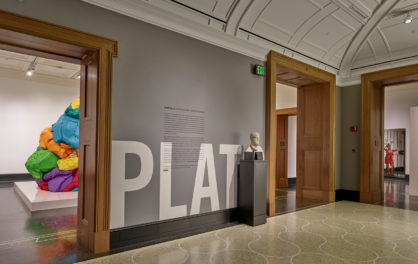December 1 has come to be known among art and AIDS organizations as Day Without Art, which coincides with World AIDS Day. Now in its 28th year, Day Without Art is a call to action against the AIDS pandemic and its devastating effect on art and culture.
This year, we show our support of #MyRightToHealth and are motivated as well by current efforts in the United States to pass a bill that would eliminate the tax deduction on medical expenses—a deduction that helps almost nine million Americans a year offset the financially devastating cost of medical crises, chronic illnesses, and disabilities. To us as curators of manuscripts, centuries-old images in our collection have enduring relevance not just as art, but as social commentary and exhortation to compassion.
Several objects from our upcoming exhibition Outcasts: Prejudice and Persecution in the Medieval World demonstrate these messages. The manuscript image above is especially relevant for Day Without Art, as it focuses on healthcare and leprosy, one of the most devastating diseases in the Middle Ages. Artist and bodyworker Ron Athey encouraged us to include the illumination in the exhibition, and we are grateful for his insights about stigma and healing. Here’s how we describe the scene:
“Whatever you did for one of the least of these brothers and sisters of mine, you did for me.” Taken from the Gospel of Matthew, Christ’s words about charity are written in Latin above this scene of a nun feeding a leper in a hospital. Even in the Middle Ages, medical care was available to those with preexisting conditions and terminal illnesses, though treatment was rarely provided by physicians. It was clerics who were tasked with ministering to the physical and spiritual needs of the sick. Meals and medicine were communally provided after admission to a hospital, but some of the poorest members of society were compelled to raise funds for their care. The stigma attached to diseases such as leprosy, the plague, or later, syphilis, however, cut across all social classes.
The stigma of disease does indeed still cut across all social classes. We are therefore also spurred to reflect on images and texts that communicate medieval ideas about class, privilege, wealth, and the politics associated with one’s identity (class, gender, race, sexuality, and so forth).
The biblical story of a poor man rejected by a wealthy man was frequently depicted in the Middle Ages. Here’s an example from a personal prayer book, with our description of the scene:

Initial B: David Playing the Harp in a breviary, about 1320–25, unknown artist, made in Paris, France. The J. Paul Getty Museum, Ms. Ludwig IX 2 (83.ML.98), fol. 7
The hierarchies of social class are visualized on this page through the pairing of biblical scenes. At the bottom of the page, the rich man Dives dines at a bountiful banquet but selfishly denies Lazarus, a poor beggar, a few scraps of food. Here, dogs lick the sores on Lazarus’s body. This New Testament parable, in which the rich man is punished with damnation for his lack of charity, corresponds thematically with the text of Psalm 1, attributed to King David, who is shown within an initial B: “Blessed is the man who does not walk in the counsel of the wicked, nor stand in the way of sinners, nor sit in the seat of the scornful.”
Wealthy patrons included images of Christian charity in their books, but such pictures often appeared alongside satirical images of the poor and disabled. This paradox is clear in a late-medieval object in our collection, the Prayer Book of Charles the Bold, and it serves as a case study on patronage, power, and privilege.

Saint Martin Dividing His Cloak in the Prayer Book of Charles the Bold, 1469, Lieven van Lathem, made in Ghent and Antwerp. The J. Paul Getty Museum, Ms. 37 (89.ML.35), fol. 34v
Saint Martin of Tours embodied the Christian “works of mercy,” which included clothing the poor and caring for the disabled. Martin, a Roman soldier, cut a portion of his cloak to clothe a beggar. The image at the bottom of the manuscript page, in contrast, features a mock joust between two peasants with baskets on their heads, mounted on rams. The artist created a joke at the expense of the poor, who here serve as simple sources of amusement.
In contrast to Saint Martin’s charity, the patron of this manuscript, Duke Charles the Bold, was known for wearing lavish garments made from cloth-of-gold silk. He incurred large debts, and his dealings with foreign cloth merchants as well as the Medici Bank, among others, led to bankruptcy.
Returning to the Day Without Art, we remember the historical persecution faced by members of the LGBTQ+ communities, even before the AIDS pandemic. This prejudice cuts across all levels of class and society, as one manuscript in the Getty collection reminds us (read more about queer sanctity and stigma here).
Here is how we describe the manuscript in the exhibition:
Rumor and hearsay shape historical interpretation and scholarship. Embellishing his account of political negotiation at the French court, historian Jean Froissart (1337–1405) shared a defamatory anecdote: he wrote that Jean, Duke of Berry (1340–1416), was infatuated with a boy at court who specialized in manufacturing knitted undergarments. The artist depicted the duke, at far right, placing his hand on the shoulder of the youth, whose short tunic and hose reveal his buttocks, as was fashionable at the time. Froissart’s “outing” of this French ruler exemplifies a frequent rhetorical tactic for undermining a person’s moral and spiritual reputation. Such allegations fueled interpretations by later art historians of latent homosexual content in illuminated manuscripts commissioned by the duke.

The Embassy of the Duke of Brabant before the King of France and the Duke of Berry (and detail), about 1480–83, Master of the Getty Froissart. From Jean Froissart’s Chronicles, book 3, made in Bruges. The J. Paul Getty Museum, Ms. Ludwig XIII 7 (83.MP.150), fol. 272v
We encourage readers to join the conversation about Day Without Art by visiting the Visual Aids website for this year’s theme and related programming, Alternate Endings / Radical Beginnings.





Comments on this post are now closed.